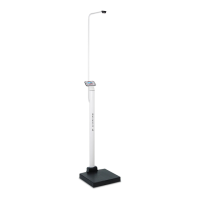3300-0188-0M Rev L y apex Digital Scale Owner’s 2
SITE PREPARATION REQUIREMENTS
The apex® Digital Clinical Scale is a precision weight indicating instrument. As with any
precision instrument, it requires an acceptable environment to operate at peak performance
and reliability. This section is provided to assist you in obtaining such an environment.
Environmental
x For indoor use only.
x Suitable for dry environments only RH < 90% and non-condensing environments.
x NEVER allow scale to get wet.
x The scale meets or exceeds all certification requirements within a temperature range
of 14 to 104 °F (-10 to +40 °C).
The scale should be placed out of direct sunlight and to provide adequate air circulation,
keep the area around the scale clear.
Do not place the scale directly in front of a heating or cooling vent. Such a location will
subject it to sudden temperature changes, which may result in unstable weight readings.
Ensure that the scale has good, clean AC power and is properly grounded. In areas subject
to lightning strikes, additional protection to minimize lightning damage, such as surge
suppressors, should be installed.
Electrical Power
The apex® Digital Clinical Scale has been designed to operate from a 100 to 240 VAC
50/60Hz 12 VDC 1 A wall plug-in UL/CSA listed AC power adapter. Note that a special
order is not required for operation at 230 VAC.
The socket-outlet supplying power to the scale should be near the scale and should be
easily accessible.
On installations requiring 230 VAC power, it is the responsibility of the customer to
have a qualified electrician install the proper power adapter plug that conforms to
nati
onal electrical codes and local codes and ordinances.
Electrical Noise Interference
To prevent electrical noise interference, make certain all air conditioning and heating
equipment, lighting or other equipment with heavily inductive loads, such as welders, motors
and solenoids are on circuits separate from the system. Many of these disturbances can
seriously affect the operation of the system. These sources of disturbances must be
identified and steps must be taken to prevent possible adverse effects on the system.
Examples of available alternatives include isolation transformers, power regulators,
uninterruptible power supplies, or simple line filters.

